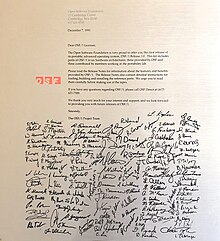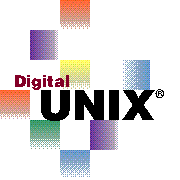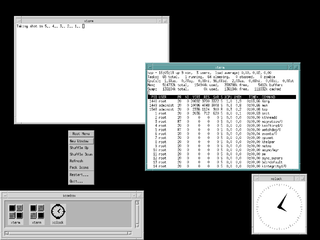History
This section needs additional citations for verification .(January 2014) |
The organization was first proposed by Armando Stettner of Digital Equipment Corporation (DEC) at an invitation-only meeting hosted by DEC for several Unix system vendors in January 1988 (called the "Hamilton Group", since the meeting was held at DEC's offices on Palo Alto's Hamilton Avenue). [3] It was intended as an organization for joint development, mostly in response to a perceived threat of "merged UNIX system" efforts by AT&T Corporation and Sun Microsystems. After discussion during the meeting, the proposal was tabled so that members of the Hamilton Group could broach the idea of a joint development effort with Sun and AT&T. In the meantime, Stettner was asked to write an organization charter. That charter was formally presented to Apollo, HP, IBM and others after Sun and AT&T rejected the overture by the Hamilton Group members.
The foundation's original sponsoring members were Apollo Computer, Groupe Bull, Digital Equipment Corporation, Hewlett-Packard, IBM, Nixdorf Computer, and Siemens AG, sometimes called the "Gang of Seven". Later sponsor members included Philips and Hitachi with the broader general membership growing to more than a hundred companies. [4] [5] It was registered under the U.S. National Cooperative Research Act of 1984, [6] which reduces potential antitrust liabilities of research joint ventures and standards development organizations.
The sponsors gave OSF significant funding, a broad mandate (the so-called "Seven Principles"), substantial independence, and support from sponsor senior management. Senior operating executives from the sponsoring companies served on OSF's initial Board of Directors. One of the Seven Principles was declaration of an "Open Process" whereby OSF staff would create Request for Proposals for source technologies to be selected by OSF, in a vendor neutral process. The selected technology would be licensed by the OSF to the public. Membership in the organization gave member companies a voice in the process for requirements. At the founding, five Open Process projects were named.
The organization was seen as a response to the collaboration between AT&T and Sun on UNIX System V Release 4, and a fear that other vendors would be locked out of the standardization process. This led Scott McNealy of Sun to quip that "OSF" really stood for "Oppose Sun Forever". [7] The competition between the opposing versions of Unix systems became known as the Unix wars. AT&T founded the Unix International (UI) project management organization later that year as a counter-response to the OSF. UI was led by Peter Cunningham, formerly of International Computers Limited (ICL), as its president. UI had many of the same characteristics of OSF, with the exception of a software development staff. Unix System Laboratories (USL) filled the software development role, and UI was based in Parsippany-Troy Hills, New Jersey to be close to USL.
The executive staff of the Open Software Foundation included David Tory, President, formerly of Computer Associates; [8] Norma Clarke, Vice-President Human Resources formerly of Mitre; Marty Ford, Vice-President Finance, formerly of DEC; Ira Goldstein, Vice-President Research Institute, formerly of Hewlett-Packard; Roger Gourd, Vice-President Engineering, formerly of DEC; Alex Morrow, Vice-President Strategy, formerly of IBM; Donal O'Shea, Vice-President of Operations, formerly of UniSoft. This staff added more than 300 employees in less than two years. The organization's headquarters were at 11 Cambridge Center in Cambridge, Massachusetts, intentionally located in the neighborhood of the Massachusetts Institute of Technology along with remote development offices in Munich, Germany and Grenoble, France and field offices in Brussels and Tokyo. To the public, the organization appeared to be nothing more than an advocacy group; in reality it included a distributed software development organization.
An independent security software company - Addamax, filed suit in 1990 against OSF and its sponsors charging that OSF was engaged in anticompetitive practices. The court delivered a grant of summary judgment to OSF (152 F.3d 48, 50 (1st Cir.1998). [9] In a related action in 1991, the Federal Trade Commission investigated OSF for allegedly using "unfair trade practices" in its "process for acquiring technology." [10] [11]












